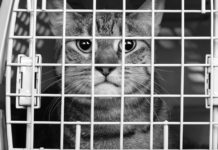How Neutering Pets Affects Feral and Stray Cats
A new mathematical model of cat populations in the United Kingdom suggests that neutering cats that belong to people not only affects the population...
Hope for Sterilization Alternatives
Feline overpopulation is a big concern for all cat lovers and a huge headache for shelters and rescue facilities. Kitten explosions lead to cat...
Neutering a Cryptorchid Cat
The term “cryptorchid” refers to a condition in which the testicles don’t descend into the scrotum appropriately. Normally, testicles descend into the scrotum between...
Handle Feline Heat Cycles
Your lovable, sweet kitten is 6 months old and has turned into a menace overnight. Nonstop meowing, pacing, rolling, and biting when you go...
Mandated Spay/Neuter Act Started in Louisiana
The Shreveport, La., City Council voted to require all pet dogs and cats in the city to be spayed or neutered, according to SmartBrief....
Must I Neuter or Spay My Cat?
Most pet cats are spayed or neutered. Dealing with pungent male urine sprayed to mark territory or the histrionics of a female cat in...
Neutered Males Are Spraying
I need information on spraying. I have four neutered males that are housed exclusively indoors, and I am having problems. Can you provide any advice about how best to address this issue?
A New Technique to Ease Pain After Spay Surgery; Hope for Feline Heart Disease
Not too long ago, conventional wisdom held that animals felt little pain and providing relief was unnecessary after spaying and neutering. Veterinary medicine today emphasizes the recognition and management of pain in animals, with professional organizations issuing guidelines, offering courses for members and expanding efforts to educate owners. Researchers, too, are pursuing pain relief, in one case discovering that a novel method of drug delivery for spayed cats provides relief.
Alternatives for Surgical Sterilization
When you adopt a kitten or a cat, the traditional plan calls for spaying or neutering as soon as possible. This common procedure is usually effective in rendering your cat sterile but does carry health risks and requires time to prep, operate and provide post-surgical care.
Ask About Advantages And Drawbacks
If you want to check out a potential clinical trial for your cat, these are questions to ask his veterinarian and the studys research coordinator.
In The News: June 2015
Researchers have struggled for years to develop a nonsurgical way to sterilize dogs and cats. Now the Gary Michelson Found Animals Foundation has awarded a Harvard professor of bioengineering a $700,000 grant to develop a vaccine to sterilize animals by disrupting gonadotropin, a hormone that controls reproduction.
The Importance of Spaying
When your lovely new purebred kitten reaches maturity, you may want to breed her, and you may already have a carefully worked-out strategy for doing so. Otherwise, there is no good reason to avoid having your new pet spayed while shes still in the early months of her life - and there are a number of compelling reasons for doing so. First and foremost among these reasons, says Andrea Looney, DVM, a lecturer in anesthesiology at the Cornell University Hospital for Animals, is that spaying - also called ovariohysterectomy - will help curb rampant feline overpopulation.















